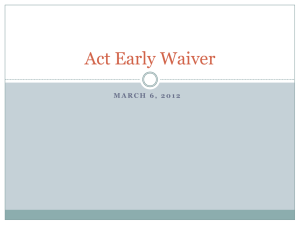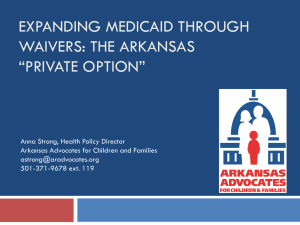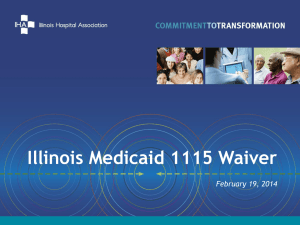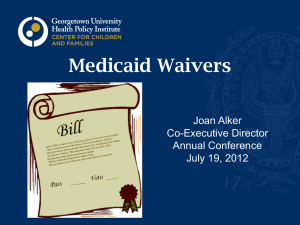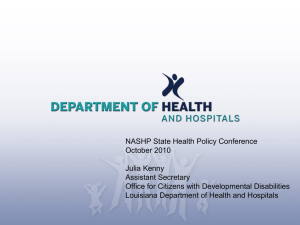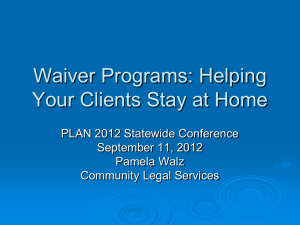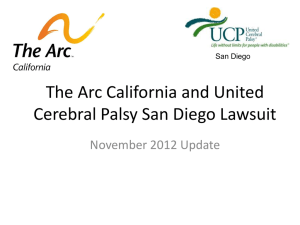MI Choice Program Update
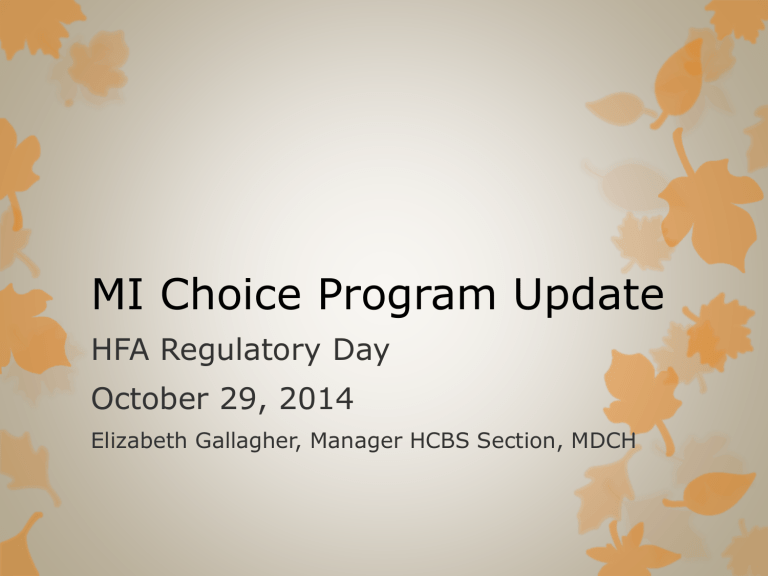
MI Choice Program Update
HFA Regulatory Day
October 29, 2014
Elizabeth Gallagher, Manager HCBS Section, MDCH
OBJECTIVES
Learn about MI Choice Program Eligibility
Medical/Functional
Financial
Service Need
Learn about the Home and Community Based Services requirements
Basic Requirements
MI Choice time frame for compliance
Process for assessing residential and non-residential settings
Corrective Action Plans
Question and Answer Session
2
MI CHOICE PROGRAM
ELIGIBILITY
3
OVERVIEW OF MI CHOICE
The MI Choice Waiver is designed to enable the elderly and younger disabled adults (age 18 & older) to remain at home and to participate in their communities. The waiver serves approximately 14,000 adults each year.
4
REFERRAL TO MI CHOICE
Persons interested in enrolling in
MI Choice must work with a waiver agency that serves their county of residence.
5
REFRRAL TO MI CHOICE
To find a local waiver agency or for more information on the MI Choice
Waiver: www.michigan.gov/mdch
Click on “Health care coverage.”
Click on “Services for seniors.”
Click on “Choices for older or disabled persons who may need help caring for themselves.”
6
REFERRAL TO MI CHOICE
Contact the preferred waiver agency in the service area
Ask for an assessment of eligibility for MI Choice waiver services.
An intake specialist will conduct a pre-screen over the phone
If applicant passes the pre-screen, the specialist will schedule an in-person assessment.
7
WAITING LISTS
Waiting lists are managed with four priority categories as listed below in descending priority:
1.
Adults aging off of Medicaid State
Plan Private Duty Nursing whose services are authorized by Medicaid
Program Review Division
2.
Nursing Facility residents
3.
Persons with active Adult Protective
Services cases or Persons at imminent risk of nursing facility placement
4.
All other applicants by date of inquiry
8
MI CHOICE ASSESSMENT
Once an applicant is at the top of the waiting list the following happens:
A supports coordination team comprised of a Registered Nurse (RN) and licensed Social Worker (SW) will meet with the applicant in their home to complete an assessment.
During the assessment, the team will determine likelihood of eligibility
Will start person-centered planning
Will start development of a plan of care if likely eligible
9
MI CHOICE ELIGIBILITY REQUIREMENTS
Must meet nursing facility level of care (NFLOC) to demonstrate medical/functional eligibility
MI Choice waiver agents must apply the Michigan Medicaid Nursing Facility
Level of Care Determination tool to persons applying for enrollment in the program
Applicants must pass through one of the seven “doors”
10
NFLOC DOORS
1.
Activities of Daily Living (Bed Mobility,
Transfers, Toilet Use, Eating)
2.
Cognitive Performance
3.
Physician Involvement
4.
Treatments and Conditions
5.
Skilled Rehabilitation Therapies
6.
Behavior
7.
Service Dependency
11
FINANCIAL ELIGIBILITY FOR MI CHOICE
WAIVER
Must be eligible for Medicaid
Maximum income is 300% SSI
($2,163/mo. GROSS in calendar year
2014)
Spousal asset protections apply – but cannot divert income to the spouse
Waiver participants are considered a group of one
Waiver participants do not have a spend-down (Medicaid Deductible)
Financial Eligibility is Determined by the Department of Human Services
12
SERVICE NEED ELIGIBILITY
Applicant must demonstrate, through the assessment process, the need for at least one MI Choice waiver service
Waiver participants must receive at least one MI Choice service (in addition to supports coordination) on a regular basis to maintain program eligibility.
13
MI CHOICE AVAILABLE SERVICES
Adult Day Health
Chore Services
Community Living
Supports
Community Transition
Services
Counseling
Environmental
Accessibility Adaptations
Fiscal Intermediary
Goods and Services
Home Delivered Meals
Non-Medical
Transportation
Nursing Services
Personal Emergency
Response Systems
Private Duty Nursing
Respite
Specialized Medical
Equipment & Supplies
Supports Coordination
Training
14
SERVICES IN GROUP RESIDENCES
MI Choice CANNOT:
Pay for room and board
Duplicate services required by licensure
Duplicate “usual and customary” services provided by the residence
MI Choice CAN:
Authorize services based upon the unique needs of the individual
Authorize the additional “hands on” services and supports needed by an individual
15
MI CHOICE ENROLLMENT
Cannot enroll before date of initial assessment by waiver agency
Can receive all Medicaid State Plan
Services
Cannot use both MI Choice and Home
Help program for personal care services.
Must use MI Choice Community
Living Supports for ADL/IADL needs
16
MI CHOICE ENROLLMENT
Two Options for Service Delivery
Traditional/Agency Based
All workers must be employed by an agency in the waiver agency’s provider network.
Self-Determination
Can choose own workers
Workers cannot be legally responsible for participant (i.e. spouse or guardian)
Participants can use a mixture of
Traditional and Self-Determined services 17
MI CHOICE POLICY
MI Choice Chapter in Medicaid Policy
Manual can be found at: http://www.mdch.state.mi.us/dchmedicaid/manuals/MedicaidProviderM anual.pdf
18
APPLICANT’S RIGHT TO APPEAL
Waiver agency must inform applicant of their right to appeal throughout the process
If applicant put on waiting list
If applicant does not pass telephone screen
If applicant does not meet NFLOC
If applicant does not meet other enrollment criteria
If applicant requests services that are not authorized
19
HOME AND COMMUNITY BASED
SETTINGS RULING
20
HCB SETTINGS RULING
Published in the Federal Register
(CMS-2249-F; CMS-2296-F) on
January 16, 2014
Effective March 17, 2014
Transition plan due by March 17,
2015 or sooner if updating a waiver program
Must be fully compliant by March
17, 2019, or sooner
21
FEDERAL INTENT OF THE RULING
To assure Medicaid-eligible persons who are part of a home and community based services program have the same access to the community in which they reside and opportunities to be a part of the community as persons who are not participants of a
Medicaid-funded program.
22
REQUIRED QUALITIES
Integrated & supports full access to the community, including employment, controlling personal resources & receiving services
The individual selects the setting
Ensures the individual’s rights of privacy, dignity and respect and freedom from coercion & restraint
Optimizes initiative, autonomy & independence
Facilitates choice re: services & supports & providers
23
SETTINGS THAT ARE NOT HCB
Nursing Facilities
Institution for Mental Diseases
Intermediate Care Facility for Individuals with Intellectual Disabilities
Hospitals
24
SETTINGS PRESUMED NOT HCB
Publicly or Privately owned facility providing inpatient treatment
On the grounds of or next to a public institution
Settings that separate Medicaid
HCBS recipients from other members of the community
The state can make a case to the
Federal Government if one of these settings meets HCB requirements
25
PROVIDER OWNED SETTINGS
Must also assure:
A specific physical place that can be owned, rented or occupied under a legally enforceable agreement and individual has same legal protections as others
Individuals have privacy in sleeping units
Entrance doors lockable
Choice of roommates
Can furnish & decorate unit
Control own schedules and activities and access to food at any time
Have visitors at any time
Setting is physically accessible
Modifications to above must be documented in PCP 26
MICHIGAN TRANSITION PLANS
MDCH is working on a statewide plan http://www.michigan.gov/mdch/0,4612,7-132-
2943-334724--,00.html
MI Choice submitted a plan to CMS on
9/28/2014
The Habilitation Supports Waiver submitted a plan to CMS on 9/30/2014
All plans will be coordinated
27
MI CHOICE PLAN: ASSESSMENT
Residential and non-residential settings
Completed by 9/30/2015
Conducted by MI Choice waiver agencies
Using tools developed by CMS, but modified by
MDCH with stakeholder input
On-site
28
MI CHOICE PLAN:
OUTREACH & ENGAGEMENT
Completed
Initial Stakeholder Meetings
Public Notice & Comment
Revised & posted transition plan
Post Public notice of assessment results by 7/31/2015
Present Assessment results to stakeholders by 8/31/2015
29
MI CHOICE PLAN: REMEDIATION
By 6/30/2015
Update policies, procedures, and contract requirements
Add educational component to provider enrollment process
Update provider monitoring tool
30
MI CHOICE PLAN: REMEDIATION
By 12/31/2015
Analyze assessment data
Notify providers of meeting or not meeting requirements
Notify CMS if presumed settings should have exception
Require remediation plans from providers
31
MI CHOICE PLAN: REMEDIATION
By 12/31/2016
Offer choices to participants in settings that do not meet requirements
Transition to setting that meets requirements
Disenroll from MI Choice
32
QUESTIONS?
Elizabeth Gallagher
GallagherE@michigan.gov
517-335-5068
Heather Slawinski
SlawinskiH@michigan.gov
517-373-0324
33
